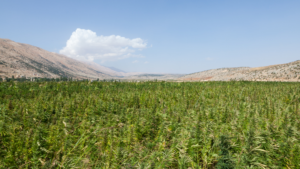Cannabis has a long history in ancient India. It has been used for thousands of years for its therapeutic benefits in Ayurveda. Cannabis also has religious and spiritual significance for not only India but for much of Central Asia.
Over the centuries cannabis became demonised and even criminalised in the West and Europe. Despite this, its use has remained prevalent throughout India and indeed the world for physical and mental health.
This article explores the ancient origins of cannabis in India and the system of Ayurveda. It also discusses how it has developed and changed up until the present day.
What is Ayurveda
Ayurveda is the ancient Indian system of medicine which has been practised for over 3000 years. It seeks to bring the body into harmony by balancing the three functions elements. These elements are called doshas, which are Vata, Pitta & Kapha.
Vata is associated with the element of wind and refers to the functions of the central and sympathetic nervous system. Pitta is associated with the element of fire. It refers to the metabolism, heat production, digestion and various secretions and excretions. Kapha is associated with the element of water. It refers to the functions of heat regulation and the formation of fluids such as mucus and phlegm.
Ayurveda depends upon creating an equilibrium between these three elements in the body. Diseases can be attributed to an imbalance in the dosha system due to internal or external causes. When an imbalance in the body is found, it is treated with a combination of religious and prescriptive regimens and herbal therapies. Herbal therapies have become the predominant ayurvedic treatment known of and prescribed today.
There are over 2000 known ayurvedic medicinal plants used in treatments. Cannabis is and always has been an important medicinal plant used in Ayurveda.
Ayurveda is a combination of the Sanskrit words for life and knowledge. It is an ancient health system steeped in faith and mysticism. Similarly, cannabis has been bound to faith and mysticism in India for thousands of years in the Hindu and Islamic traditions.

The history of the use of medicinal cannabis in India
The origins of cannabis in India
It is thought that cannabis originated from somewhere in Central Asia or at the foothills of the Himalayas. There has been evidence of cannabis flowers and seeds used in the hallucinogenic brew known as soma. This was found in ancient Bactrian sites in Turkmenistan dating to 2000BC. The term bhang also seemingly originated from people in Central Asia.
The holy book of Zoroastrianism, dating back to 600BD in Persia, alludes to the use of bhang in a medical context. It was probably the people of Northern Iran who discovered the intoxicating effects of cannabis. They were using the leaves and resin for their psychoactive effects before Hindus.
Documented evidence of the use of cannabis in India
The earliest written reference to cannabis in India may have occurred in the Atharvaveda, dating back to 1500BC. This text mentions the use of bhang in the preparation of soma. It was likely used as an offering, ingestion or burning as part of an ancient practice.
In the Sushruta Samhita dating back to between 300 & 800BC cannabis was recommended for excessive phlegm and diarrhoea. It was used in ancient Indian medicine in treatments for pain and as an anaesthetic when combined with alcohol.
Around the 7th century, there was a development of tantric cannabis use in ritual as Shaivism mingled with Tibetan Buddhism. The Anandakanda (The Root of Bliss, 1200CE) documents 43 Sanskrit synonyms for cannabis which allude to its remarkable rejuvenating effects. There is even a documented method of processing cannabis with 8 other medicinal plants. This, in combination with isolation and celibacy, claims to allow someone to live healthily for 300 years! This dates back to between the 9th-12th century.
The first uncontested source for the use of cannabis in India is from the Cikitsasarasangraha written in Bengal in the late 11th century. This work described bhang as an appetizer and digestive. Stating cannabis as “a drug like opium, whose mode of action is to pervade the whole body before being digested”.
In the 13th century, the text Rajanighantu added more Sanskrit synonyms for cannabis. It was described as an excitant, heating medicine which destroys phlegm, gets rid of gas, sharpens the memory and increases appetite.
Around the same time in the Sharangadhara Samhita connected cannabis to opium and described how bhang can be used medicinally. It was cited as the primary ingredient in a therapeutic mixture of herbs to relieve diarrhoea, cough, anorexia and nasal congestion.

Cannabis as tool for spirituality and medicine
Cannabis has been called “Indra’s food” which produces infatuation, destroys leprosy and creates vital energy, mental powers and internal heat. The 15th-century Rajavallabha states:
“It was originally produced, like nectar from the ocean by the churning with Mount Mandara. It is the delight of the king of the gods. The desire-fulfilling drug was obtained by men on the earth through the desire for the welfare of all people to those who regularly use it, it begets joy and destroys every anxiety”
Bhang has also been used to treat gonorrhoea, correct derangements, sharpen wit, as a digestive and aphrodisiac. It has also been documented as a treatment for wounds, dandruff, earworms and premature ejaculation.
In the 18th century Persian medical text called Makhzan-al-Adwita cannabis was described as:
“The joy-giver, the sky-flier, the heavenly guide, the poor man’s heaven and the soother of grief”
As we can see cannabis has a long history in and Ancient India with many applications that have been extensively documented overtime.

Cannabis in the West and its decline in India
Cannabis was introduced to Western medicine in the 19th century. It was used as a treatment for tetanus, migraines, for neurological disorders, cholera, pain and even for hangovers.
Cannabis, however, has always been subject to intense scrutiny in the west due to concerns of its moral dangers. This resulted in British authorities in India organising a commission to examine all aspects of its use. The findings were presented in a 3000-page document after extensive investigations.
They found that moderate use of cannabis had no negative physical effects on the body. Excessive use could weaken the body (as with all drugs). Moderate use had no adverse effect on the brain, except for those with a predisposition for mental disease. It also stated that moderate use had no adverse influence on morality. This commission advocated against the suppression of cannabis by the government.
It was noted in the commission that cannabis has been used for centuries and that it must be looked upon as one of the most important drugs of Indian Materia Medica.
The decline of the acceptability of cannabis in India can be attributed to the fact that a few individuals became deranged from the abuse of cannabis. These few individuals came to be taken as representative of all those in India who used cannabis. This resulted in the colonial government of India developing an image of all Indian users of cannabis as dangerous, crazy and violent.
The use of cannabis in 20th century India
Despite this, the use of cannabis remained common in India in the 20th century. In the 1950s it still remained an integral part of the Indian faith. Cannabis has been described as giving good bhakti or devotion.
The remarkable therapeutic benefits were noted during this time. Along with the observation that it doesn’t damage the respiratory system and isn’t addictive. Cannabis was still being used to treat pain, help with digestion, fight inflammation, as an aphrodisiac and even to soothe toothaches and treat conjunctivitis.
Cannabis continued to be used for conditions including insomnia, asthma, gynaecological conditions, whooping cough and malaria. It was noted for its spiritual significance by, “freeing them from worldly bonds and inducing communion with the divine spirit”.
Cannabis was criminalised in India in 1985 as a result of pressures from Western counterparts like the USA. However, cannabis was still widely used by Indians as medicine and for its psychoactive effects. In particular, it continued to be used by people living in remote villages with little to no access to pharmaceutical drugs.
Village doctors in India provided 80% of the population with medical care. They argued that cannabis should still be allowed to be used by Ayurvedic physicians until “modern medicine is able to reach rural parts of India”.

Modern use of Cannabis in India
Despite its criminalisation, cannabis is still widely used throughout India. The use of bhang is prevalent in Varanasi, Ajmer & Jaisalmer. These three places are where bhang is allowed to be sold legally due to its religious significance.
People of all socioeconomic statuses use cannabis, including businessmen and the highly educated. Most users employ it to relieve anxiety, improve their mood, boost appetite and help them to sleep.
In the last 10 years, the medicinal use of THC & CBD has exploded. Many people are rediscovering the medicinal benefits of cannabis regardless of its psychoactive properties. CBD offers an alternative to THC, which offers many of the same health benefits without the psychoactive effects.

There is a growing body of research that is being done on the health benefits of cannabis. This research supports the application of cannabis as a treatment for many diseases it has been used to treat for thousands of years in India.
Modern-day cannabinoid researchers have even acknowledged the integral role that Indian culture has played on our understanding on the biochemistry of cannabis by dubbing the first endocannabinoid “anandamide”, ananda meaning bliss in Sanskrit.





